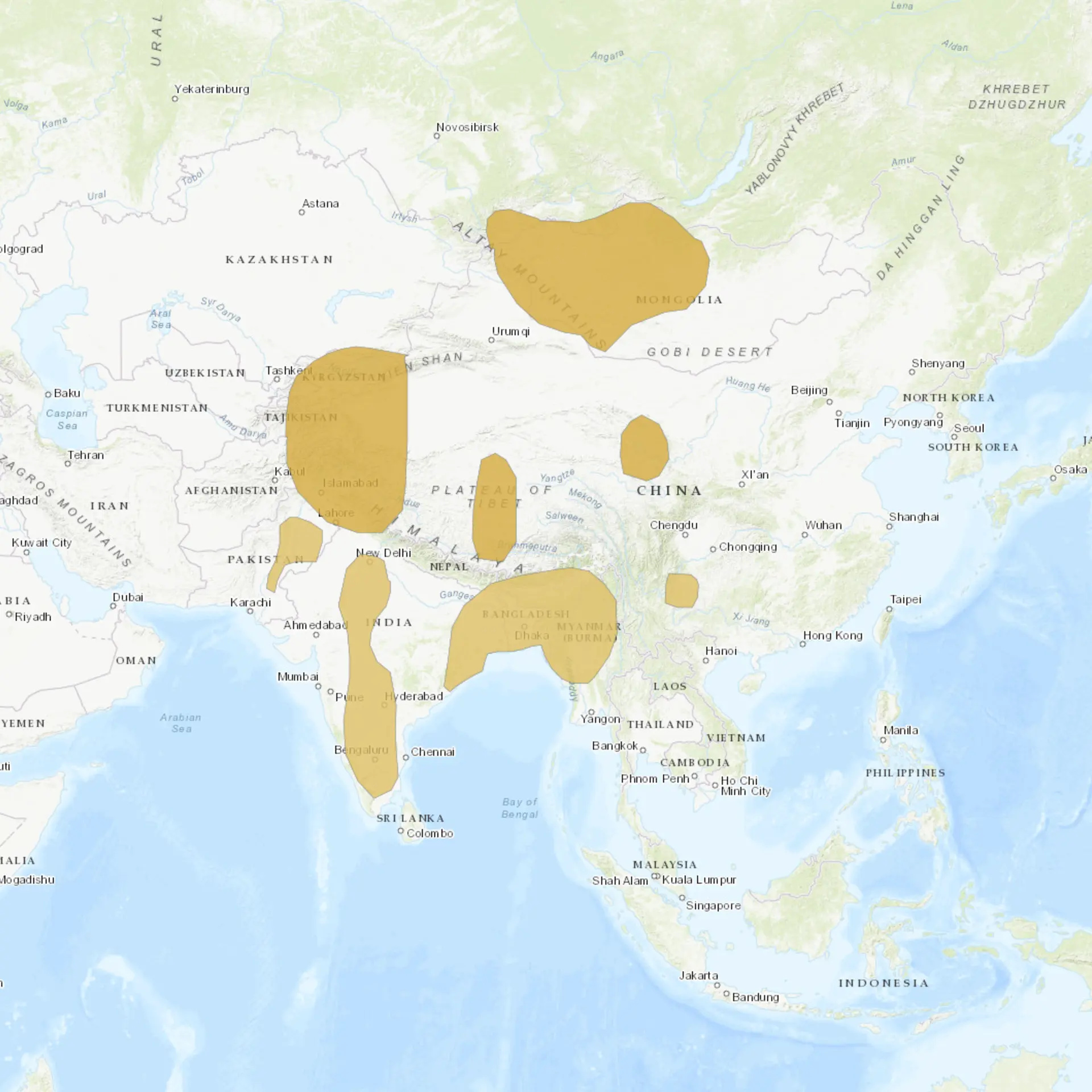Overview
The Bar-headed Goose (Anser indicus) is renowned for its remarkable high-altitude migratory flights, often seen soaring above the Himalayas. These birds are medium-sized geese with distinctive black bars on their white heads, a pattern that gives them their common name. They have a predominantly grey body, white face and neck and black bars across the back of their head. The species is adapted to various environments but is particularly noted for its ability to thrive in cold, oxygen-thin high altitudes.
Bar-headed Geese are strong fliers known for their incredible endurance and ability to fly over the tallest mountain ranges in the world. They migrate seasonally between their breeding grounds in Central Asia and wintering grounds in South Asia, particularly India. This journey is one of the most demanding migrations in the avian world, requiring the birds to cross the Himalayas, often at altitudes where oxygen levels are half that at sea level. Their physiological adaptations to these conditions are a subject of significant scientific interest.
Outside the breeding season, these geese are quite social and can be found in large flocks near lakes, wetlands, and rivers. During the breeding season, they become more territorial and pair off to raise their young in the high-altitude lakes of the Tibetan Plateau and nearby regions. The Bar-headed Goose plays a crucial role in these ecosystems, acting as a seed disperser and indicator of the environmental health of their habitats.
Taxonomy
Kingdom
Phylum
Class
Order
Family
Genus
Species
Type
Current distribution:
Depending on the season, the bar-headed goose has a wide but fragmented distribution across Central and South Asia. It is found in high-altitude regions of countries such as China, Mongolia, and Kyrgyzstan during the breeding season, especially on the Tibetan Plateau. In winter, it migrates southward to India, Pakistan, Nepal, and Myanmar, where it is commonly seen in wetlands and agricultural areas. Small populations have also been recorded in Afghanistan and parts of Southeast Asia.
The species follows well-established migratory routes over the Himalayas, including stopovers in regions like Ladakh and Nepal. These migration patterns make them highly dependent on specific habitats, both for breeding and wintering. While their global population is stable, local declines have been observed where wetlands have been drained or converted for agriculture. Their adaptability to human-altered landscapes, such as crop fields, has allowed them to persist in some regions despite these challenges.
Physical Description:
The Bar-headed Goose is distinguished by its unique head pattern, with two horseshoe-shaped black bars on its white head and neck. The rest of the body is primarily grey, with a lighter underside and darker back. They typically measure about 71-76 cm in length and have a wingspan ranging from 140 to 160 cm, showcasing their adeptness for long-distance flight. The legs and beak of these geese are orange to yellow, providing a striking contrast to their otherwise muted coloration.
Adults are similar in appearance, though males tend to be slightly larger and heavier than females. The robust body and strong wings of the Bar-headed Goose are adaptations for long migratory flights and life in rugged terrains. During flight, their long necks stretch out in front, and their powerful wingbeats are a sight against the mountainous backdrop. Juveniles resemble adults but have less distinct head markings and a more uniformly colored body.

Lifespan: Wild: ~12 Years || Captivity: ~30 Years

Weight: Male: 4.4–6.6 lbs (2–3 kg) || Female: 3.3–5.5 lbs (1.5–2.5 kg)

Length: Male & Female: 28-30 in (71-76 cm)

Wingspan: Male & Female: 55-63 in (140-160 cm)

Top Speed: 50 mph (80 km/h)
Characteristic:
Native Habitat:
Bar-headed Geese breed in Central Asia, particularly around the high-altitude lakes of the Tibetan Plateau, Mongolia, and parts of Russia. They prefer open, wetland environments where they can find abundant food and suitable nesting sites. Their remarkable adaptation to high-altitude life allows them to inhabit areas inhospitable to most other birds.
In the winter, they migrate south to spend the colder months in India and Myanmar’s warmer wetlands, lakes, and rivers. These wintering grounds provide the food and shelter they need to survive the season before returning to their breeding grounds in the spring. The preservation of both their breeding and wintering habitats is vital for their continued survival.
Biomes:
Biogeographical Realms:
Continents:
Countries:
Diet:
Diet & Feeding Habits:
Bar-headed Geese are primarily herbivores, feeding on grasses, grains, and occasionally small aquatic plants and invertebrates. They graze on land and in shallow water, often foraging in flocks during the non-breeding season. Their diet shifts slightly depending on the season and available resources, focusing on high-energy foods before and during migration to sustain their strenuous journeys.
In their wintering grounds, these geese are often found in agricultural fields, feeding on crops and leftover grains. They have adapted to a wide range of feeding habitats, from the wetlands of India to the high-altitude meadows of Tibet. Understanding their feeding patterns and migration routes is crucial for their conservation, as land use and agriculture changes can significantly impact their food sources and migratory success.
Mating Behavior:
Mating Description:
Bar-headed Geese are monogamous, typically forming long-lasting pair bonds. Their breeding season starts as the weather warms and the snow begins to melt on the Tibetan Plateau, usually around April or May. During this time, they engage in elaborate courtship displays involving synchronized head movements and vocalizations to strengthen pair bonds and establish territory.
Nests are built on the ground near water, using vegetation and down feathers. The female lays 3-8 eggs, which she incubates for about 27-30 days while the male guards the surrounding area. Once hatched, the goslings are precocial, able to walk, swim, and feed themselves shortly after birth. Both parents are involved in rearing the young, leading them to feeding grounds and protecting them from predators.
Reproduction Season:
Birth Type:
Pregnancy Duration:
Female Name:
Male Name:
Baby Name:
Social Structure Description:
Outside the breeding season, Bar-headed Geese are quite social and can be found in large flocks. They engage in group feeding and migratory behaviors, benefiting from the safety and efficiency of numbers. During migration, they fly in V formations, which helps reduce individual energy expenditure and facilitates communication among the flock.
During the breeding season, they become more territorial and pair off to raise their young. Parental care is shared, with both the male and female involved in protecting and raising the goslings. The strong pair bond and cooperative parenting are key to their reproductive success.
Groups:
Conservation Status:
Population Trend:
The global population of Bar-headed Geese is not precisely known, but they are considered widespread and numerous across their range. However, there are indications that certain populations may be decreasing due to habitat loss, hunting, and disturbance along their migratory routes. Regular monitoring is necessary to better understand their population dynamics and implement effective conservation strategies.
While listed as Least Concern, the species is susceptible to environmental changes, particularly in breeding and wintering grounds. Conservation efforts focus on protecting crucial habitats, regulating hunting, and mitigating other human impacts that could threaten these remarkable birds.
Population Threats:
Bar-headed Geese face several threats, including habitat loss and degradation due to agricultural expansion and urban development. Pollution can also impact their health and breeding success, particularly in wetland habitats. Hunting and egg collection are concerns in some areas, as is disturbance from increased human activity along their migratory routes.
Climate change poses a long-term threat, potentially altering their migratory patterns and the availability of food and breeding sites. As they depend on specific environmental conditions for breeding and migration, temperature and precipitation changes can significantly impact their populations.
Conservation Efforts:
Conservation efforts for Bar-headed Geese include habitat protection and restoration, particularly in their crucial breeding and wintering areas. International cooperation is vital, as the birds migrate across national borders and require conservation action in multiple countries. Efforts are also made to regulate hunting and reduce disturbance in key areas.
Research and monitoring are ongoing to better understand their ecology, migration, and population dynamics. This knowledge is crucial for developing effective conservation strategies and ensuring the species’ long-term survival. Environmental education and awareness campaigns help to promote the importance of protecting these unique birds and their habitats.
Additional Resources:
Fun Facts
- Bar-headed Geese are among the world’s highest-flying birds, often flying over the Himalayas at up to 29,000 feet.
- They have specialized hemoglobin in their blood, allowing them to absorb oxygen more efficiently in low-oxygen environments.
- Bar-headed Geese have been observed flying through mountain passes in the Himalayas to avoid the highest peaks, demonstrating impressive navigational skills.
- Their migration over the Himalayas is timed to coincide with favorable wind conditions, helping them conserve energy during the strenuous journey.
- Unlike many other waterfowl, Bar-headed Geese can rapidly ascend to great heights, a necessary adaptation for crossing tall mountain ranges.
- They are revered in many cultures and have been depicted in art and literature throughout history.
- Bar-headed Geese are considered a delicacy in some of their range, leading to hunting pressure in those areas.
- They have a unique call, described as a loud and trumpeting sound, which can be heard over long distances.
- During migration, these geese can cover up to 1,000 miles in just one day with the help of tailwinds.
- They are one of the few birds capable of flying without thermal updrafts, relying solely on their flapping power to ascend to great heights.




















































































